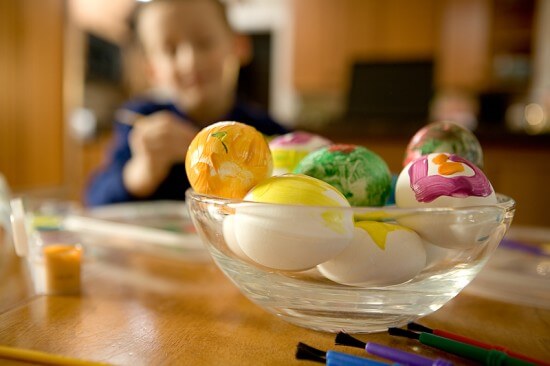
The egg may just be nature’s perfect package. The simple egg has, during the span of history, represented mystery, magic, medicine, food and omen. And most prominently it is the universal symbol of Easter celebrations throughout the world. The egg has been (and continues to be) dyed, painted, adorned and embellished in the celebration of its special symbolism.
Yet long before the egg became closely entwined with the Christian Easter, it was honored during many rites of spring festivals. Many people including the Romans, Gauls, Chinese, Egyptians and Persians all cherished the egg as a symbol of the universe. From ancient times to today eggs were dyed, exchanged and shown reverence.
In Pagan times the egg itself represented the rebirth of the earth. After the long, hard winter was over; the earth would burst forth and was reborn just as the egg miraculously burst forth with life. Therefore, the egg was believed to have special powers. This belief was so strong that eggs were buried under the foundations of buildings to ward off evil; pregnant young Roman women carried an egg on their persons to foretell the sex of their unborn children; and French brides stepped upon an egg before crossing the threshold of their new homes.
With the advent and growth of Christianity the symbolism of the egg changed to represent, not nature’s rebirth, but the rebirth of man. Devout Christians embraced the egg symbol and likened it to the tomb from which Christ rose.
Old Polish legends went even further when they blended folklore and Christian beliefs and firmly attached the egg to the Easter celebration. One of these legends concerns the Virgin Mary. The legend tells of the time Mary gave eggs to the soldiers at the cross. After passing out the eggs she entreated them to be less cruel and she wept. The tears of Mary then fell upon the eggs, spotting them with dots of brilliant color.
Another Polish legend tells of a time when Mary Magdalene went to the tomb to anoint the body of Jesus. She had with her a basket of eggs. When she arrived at the tomb and uncovered the eggs, the pure white shells had miraculously taken on a rainbow of colors.
During the Middle Ages decorating and coloring eggs for Easter was also a popular custom in England. It is recorded in the household accounts of Edward I, for the year 1290, an expenditure of eighteen pence for four hundred and fifty eggs to be gold-leafed and colored for Easter gifts.
Undoubtedly, the most famous decorated Easter eggs were those made by the well-known goldsmith, Peter Carl Faberge. The Russian Czar, Alexander, commissioned Faberge in 1883 to make a special Easter gift for his wife, the Empress Marie. The first Faberge egg was an elaborate egg within an egg. It had a stunningly beautiful outside shell of platinum and enameled white which opened to reveal a smaller gold egg. The smaller egg, opened to display a golden chicken and a jeweled replica of the Imperial crown. This special Faberge egg so delighted Czarina Marie that the Czar promptly ordered the Faberge firm to design further eggs to be delivered every Easter. Nicholas II, Alexander’s son, continued the custom in later years. It is believed that fifty-seven eggs were made in all.
Ornamental egg designers believe in the symbolism of the egg and celebrate the egg by decorating it with superb artistry and ornamentation. Designers use flowers and leaves from greeting cards, tiny cherubs, jewels and elegant fabrics, braids and trims, to adorn the eggs. Decorative eggs are separated, delicately hinged and glued with epoxy and transparent cement, and then when they are completed, the eggs are covered with a glossy resin finish. Although many of the omens and the mystery of the egg have disappeared today, the symbolism remains, and many artists continue in the old world tradition of adorning eggs.
